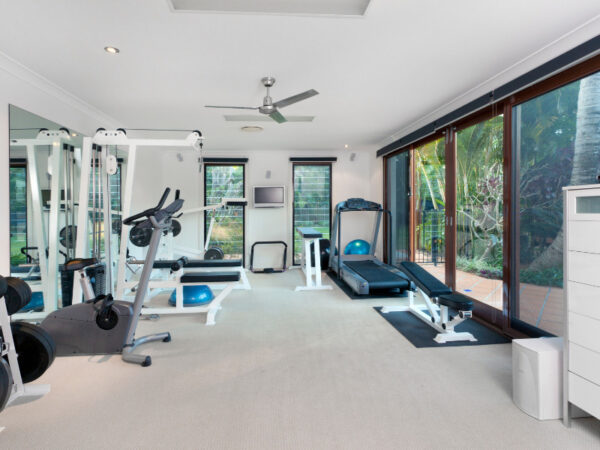
Building an at-home gym gives you the comfort and flexibility to work out whenever and however you want. At home gyms offer a private and fully customised space to exercise, which can be appealing to people of all skill levels. Whether you are an experienced lifter, or just looking to get in a quick workout after dinner, building a home gym can help you take your fitness goals to the next level. In Muskoka, home gyms can also make a great addition to your office or cottage!
Consider your budget, space, and fitness goals when building your home gym
Once you have decided to get to work on your at-home gym, you will need to consider what equipment you want to start with. There are tons of options for all budgets, spaces, and skill levels, which can make it difficult to prioritise the gear you actually need. Here are some tips for getting started on your own home gym:
- Don’t sacrifice quality for quantity. By choosing high-quality equipment, you will save money in the long run. Buy equipment that will last you years to avoid replacing your gear over and over.
- Look for functional equipment. For most of us, space is a serious consideration when putting together an at-home gym. You can easily save space by choosing equipment that is compact, portable, and easy to tuck away.
- Keep your unique fitness goals in mind. By considering the types of workouts you want to do at home and the results you are hoping to see, you can avoid spending money on equipment that you won’t use.
Each individual’s home gym requirements will look a little different. This is especially true for those with sport-specific training goals. However, there are a few pieces of equipment that are essential to any great home gym. Here are our top 8 home gym essentials:
1. Kettlebell
Kettlebells are one of the most space-friendly and versatile options for an at-home gym. Kettlebells can be used for cardio, flexibility and strength training. Full-body workouts can be crafted with kettlebells alone. This multi use capability makes them a great option for home gyms, especially where space and budget are limited. Finally, kettlebells are relatively inexpensive, and you only need one to start working out. If you are only purchasing one piece of equipment for your home gym, a kettlebell is a great place to start.
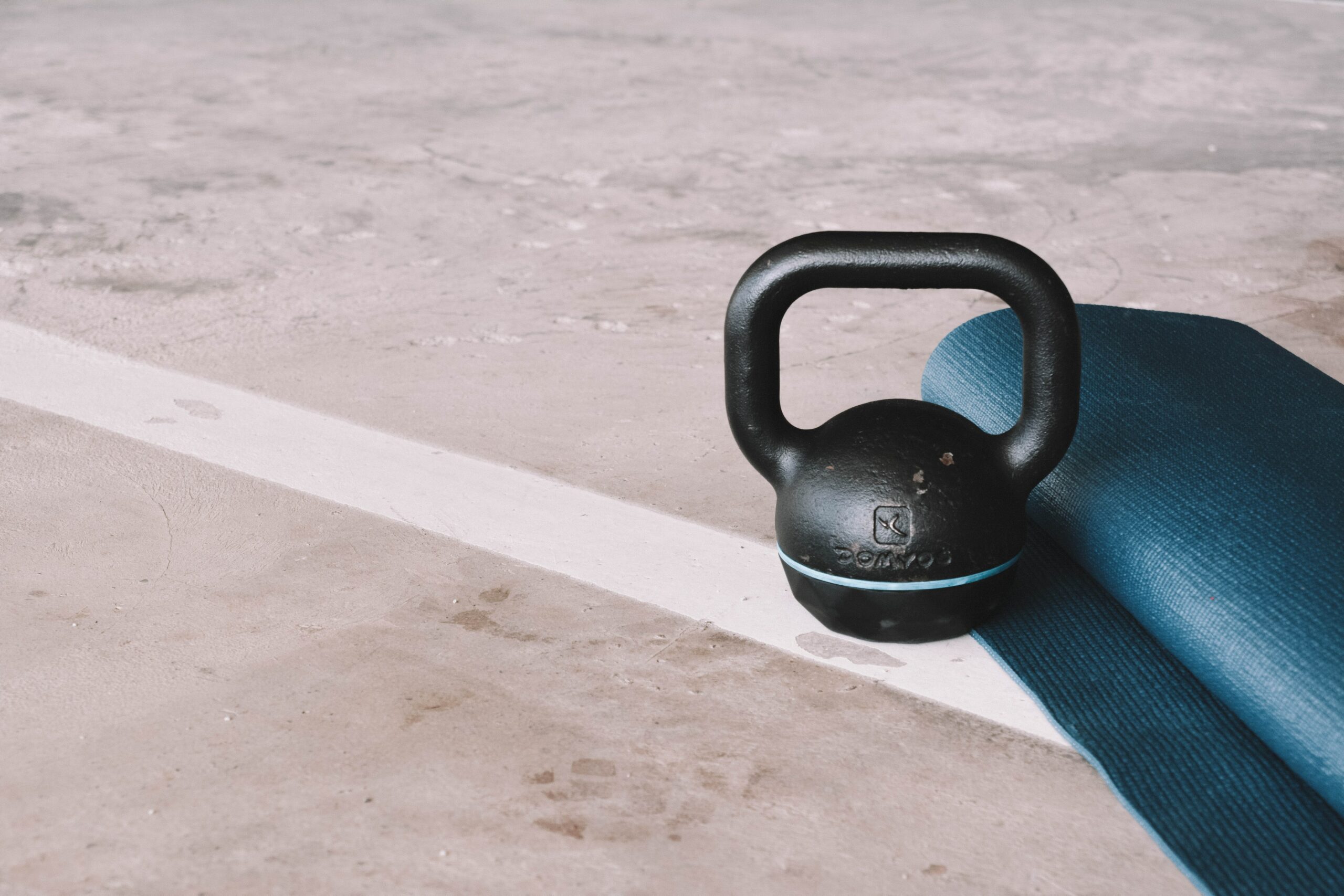
Choosing the right weight is the most important consideration when buying a kettlebell
Kettlebell exercises are generally low-impact and safe, provided you have the correct weight. For women, the recommended starting weight is 8kg for beginners, 12kg for intermediates, and 16kg for advanced users. For men, the recommended starting weight is 16kg for beginners, 20kg for intermediates, and 24kg for advanced users. However, this will vary greatly from person to person depending on their own personal abilities. If you aren’t sure which weight is right for you, or would like to learn how to effectively work out with kettlebells in the Muskoka area, the trainers at Shock Fitness can help!
Here are a few more things to look out for when purchasing a kettlebell:
- Competition vs. cast iron kettlebells: Competition kettlebells have smaller handles, while cast iron kettlebells have wider handles that can accommodate two-handed exercises. Cast iron kettlebells provide more diversity for your home gym.
- Outer coating: While some kettlebells are just cast iron, others have coatings on the outside. These coatings are often made of vinyl, which can help protect your floors when lifting and setting down the kettlebell. Avoid kettlebells with vinyl handles however, as your hands are more likely to slip off.
- Flat base: A kettlebell with a flat base can be placed anywhere without rolling around, potentially causing damage to your home’s floors.
- Comfort: Before you buy a kettlebell, test it out to make sure that it is comfortable. Seams or sharp edges on the handles could make the weight more difficult to hold. If you are planning on doing two-handed workouts, make sure that both of your hands fit comfortably into the handle of the kettlebell.
2. Dumbbells
We love dumbbells for at home gyms because they are great for a quick workout. They require little setup, and depending on the type, they can fit into small spaces. You can also isolate different muscle groups with a dumbbell, making them an essential for accessory work. Dumbbells offer the flexibility to facilitate a variety of exercises, from bench presses to lunges.
Dumbbells are available in a range of weights. They start at about 0.5lbs at the lightest, and the heaviest dumbbells are around 50lbs. If you are new to dumbbell exercises, you can judge the weight needed for a specific exercise by finding a weight that makes the workout feel challenging but manageable.
While strength and skill level both play a role in the weight of a dumbbell needed, it is also important to consider the type of exercises you will be doing at your home gym. Heavier dumbbells are typically used for lower body exercises like squats, as well as compound exercises where more than one muscle is being used. Lighter weights are typically used for upper body and isolation exercises.
Adjustable dumbbells are a space saving option for at-home gyms
There are two types of dumbbells: fixed and adjustable. Fixed dumbbells are set at a standard weight. There are a few styles of fixed dumbbells available, with the most common being hex and round. While these dumbbells are great for home gym users who only need a few different weight options, a full set can take up a lot of space.
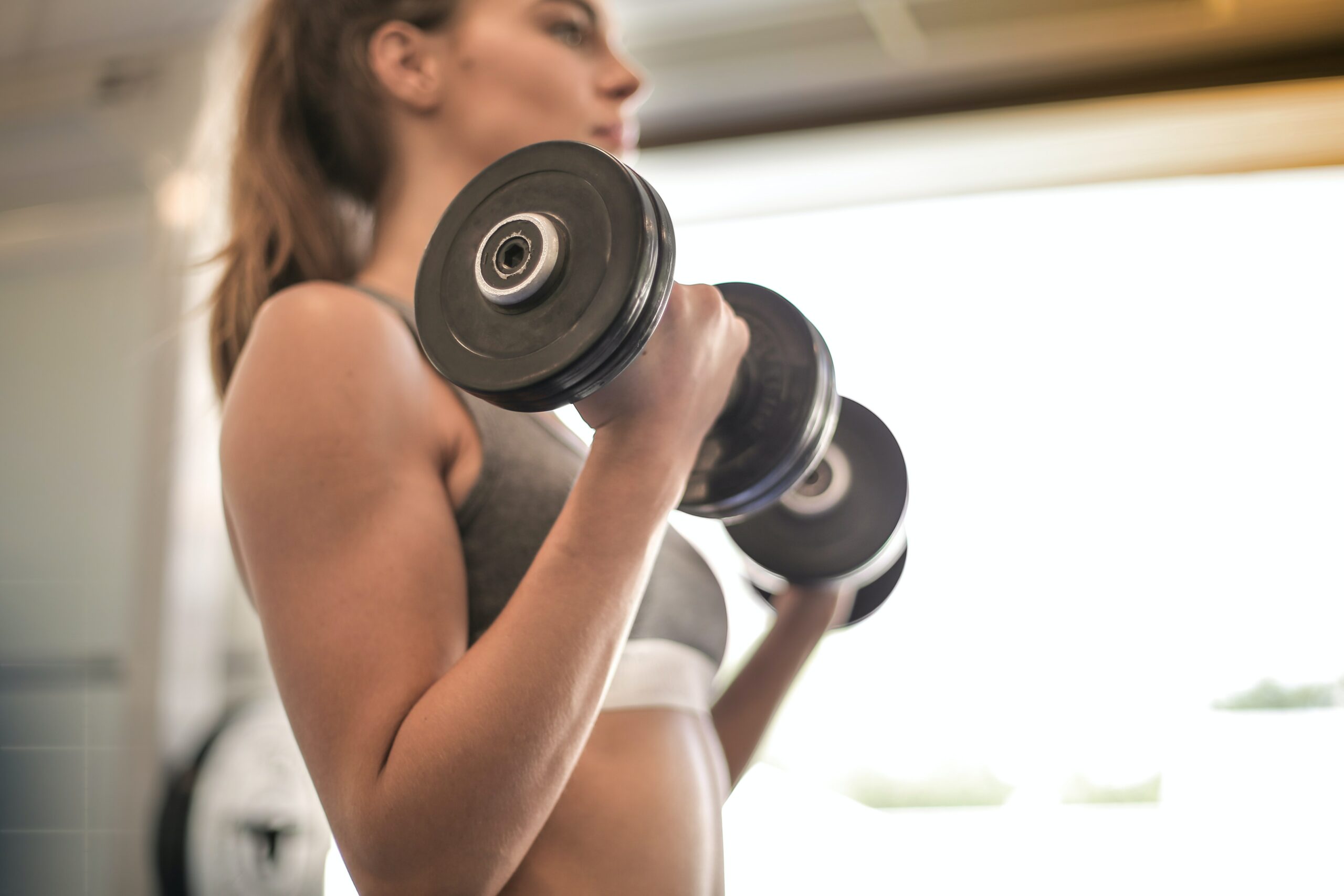
Adjustable dumbbells are a space saving and cost effective alternative to traditional dumbbells. They can replace up to 16 sets of regular dumbbells, and will allow you to quickly change the weight in seconds. Loadable adjustable dumbbells are composed of a bar and plates that can be loaded to achieve various weights, while more modern adjustable dumbbells allow you to change the weight in a matter of seconds without loading and unloading weight. Either option is a good addition to a home gym, with loadable adjustable dumbbells being a more cost-effective option.
3. Barbell
A solid barbell is a good investment for anyone who is working out at home, and is an essential part of weight training. Adding a barbell to your home gym will allow you to effectively strength train as if you were at a commercial gym. Barbell exercises are great for muscle building resistance training, and are one of the most effective ways to strength train. Barbells also allow for progression through smaller weight increments than dumbbells and kettlebells.
There are a few downsides to barbells for at-home gyms. The initial setup of a barbell home gym requires an upfront investment. You will also need a set of weight plates, and most people will want to have access to a squat rack for heavier and safer lifting. Because of this, these home gym setups typically take up more space. However, barbells are a central part of weight training so we think this investment will be worthwhile in the long run.
The type of barbell you choose should reflect your fitness and training goals. There are also different barbells for men, women, and youth. Here are three common types of barbells that you can purchase for your home gym:
- Multipurpose barbells
- Olympic barbells
- Powerlifting barbells
When it comes to purchasing a barbell for your home gym, don’t cut costs
Because barbells are such a key aspect of strength training and a centrepiece of many at home gyms, you want to make sure yours will last. There are hundreds of dumbbells available, and you might be tempted to choose a cheaper option. While it is not necessary to purchase a top of the line barbell, you do want to ensure that you are selecting a high-quality, durable barbell. Cheap barbells will corrode quickly, making them harder to grip. Over time, you may also notice these barbells starting to bend. Bent barbells will require replacement, costing you more money in the long run.
4. A set of weight plates
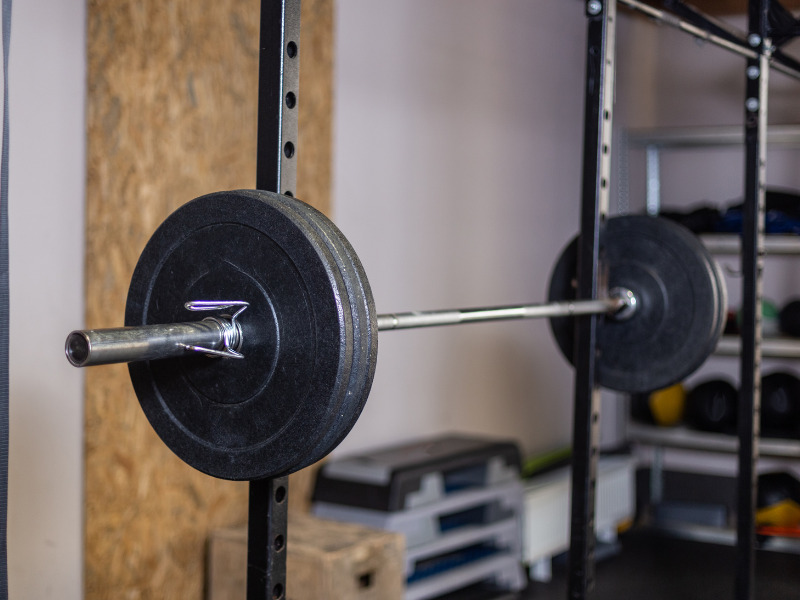
Weight plates are another essential of an at-home gym, and without them you cannot progress past the weight of your barbell. In order to effectively train with a barbell at home, you will need to invest in a set of weight plates to load onto your barbell.
The number of weight plates you should buy, as well as the weight of each plate will be different for everyone. Consider how much weight you currently lift and how much weight you would like to be able to lift in the future when purchasing your first set of weight plates. If you are looking to lift more weight than the average/intermediate lifter, you will want to purchase heavier plates. This way, you won’t have to load every plate in your home gym onto your barbell each time you want to lift.
If you are just starting out, or consider yourself an intermediate lifter, a typical starter set of weight plates will do the trick. These sets normally include:
- 2 x 45 lb
- 2 x 35 lb
- 2 x 25 lb
- 2 x 10 lb
- 4 x 5lb
- 2 x 2.5lb
Bumper plates and iron plates are both great choices for at-home gyms
There are two main types of weight plates. Bumper plates have a thick rubber coating around them. This makes them safer to drop, and offers some protection for your floors at home. Bumper plates are perfect for heavy lifting.
The other option for your home gym weight plates are iron or steel plates. These are more traditional weight plates and do not have the protective rubber coating that bumper plates have. The benefit to traditional weight plates is that they are often a more economical option, and are easily available in used marketplaces as well! Both bumper plates and iron plates will help you reach that new PR without leaving your house.
5. Squat rack
When paired with a barbell and weight plates, a squat rack can help take your resistance training to the next level. For weightlifters and powerlifters, a power rack will be a crucial part of your home or garage gym. Squat racks are also a key piece of equipment used for crossfit training.
With a squat rack, you will be able to lift more weight and build more muscle. Squat racks will give you access to more exercises that you can do at home, like barbell squats and overhead presses. Your squat rack also acts as a spotter when you are lifting alone. This is especially important for people who work out at home. With additional cable systems, a squat rack can allow you to safely lift more weight than you normally would.
Your squat rack will likely be the largest investment in your at home gym. There are racks available at a variety of budget points, but you can expect to spend upwards of $1000 on a solid rack. Like most of the equipment in this list, it is important to budget for a durable and high quality rack.
Think about the amount of space you have and the add-ons you will need for your squat rack
When you are building a home gym in a condensed area, space may be a concern for you when selecting your squat rack. While a full cage squat rack can take up a fair amount of room, there are smaller options for smaller home gyms. Compact racks are typically more shallow and sometimes shorter than a full rack, making them perfect for tighter spaces. Finally, collapsible racks or folding racks are the most condensed version of a squat rack. These racks fold up flat when they aren’t being used and can be a great space saver for small at-home gyms. While some collapsible squat racks fold out into full squat racks, others fold out into squat uprights, so it is important to consider your home workout needs when looking at this option.
Most squat racks also have optional add-ons, like pulley systems, cable catches, and pull-up bars. You can purchase these add-ons as your fitness goals evolve to help you get the most out of your home gym. Fixed package squat racks come with add-ons already built in, while modular systems allow you to select additional pieces as you go based on your own needs. If budget is a concern, modular options are a more cost-effective option.
6. Training bench
Once you have the basics, you can expand your training options by adding an adjustable bench to your home gym. A training bench will also become more important for home gyms that do not have a squat rack setup.
Training benches will offer you a greater range of exercises that would not be possible without one. Think bench press and shoulder presses. Benches also help users safely perform exercises by ensuring proper form. When you are working out at home, this is a valuable aspect of owning a bench as you may not have access to a trainer or workout buddy to correct your positions.
We recommend an adjustable bench for at-home gyms
If you’ve researched training benches for your own home gym, you’ve probably come across flat benches and adjustable benches. While flat benches still give you access to a range of exercises that you wouldn’t have without a bench, adjustable benches are ideal for home gyms.
An adjustable bench offers even more versatility because you can set the bench up in a number of different positions, from flat to sitting. Adjustable benches also take up significantly less space, so it won’t be in the way when you aren’t using it. There are a number of adjustable bench options available for all budgets, and they can be just as cost-effective as a flat bench.
7. Resistance bands
Resistance bands are one of our favourite pieces of equipment for at-home gyms. They are cost effective, incredibly versatile, and can be used for both resistance training and physical therapy. They are also hands-down the most space conscious piece of equipment on this list, taking up virtually no room in your home gym. They are so portable that you can easily travel with your resistance bands, making your home gym mobile.
With a set of resistance bands, you can effectively complete full-body workouts at home that will exercise your full range of motion. If you are new to resistance bands, you might be surprised by just how challenging resistance band workouts can be. They can also be used to enhance body weight and dumbbell or barbell exercises. By adding resistance bands, you can challenge your muscles with increased tension throughout the entire movement.
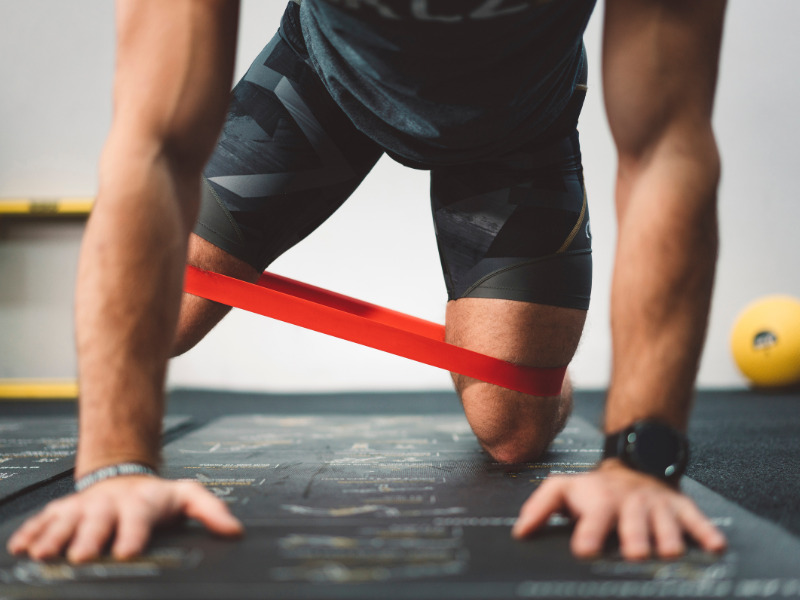
You will need more than one resistance band to accommodate full-body workouts
Resistance bands come in a range of tension levels. Different tension levels are used to exercise different muscle groups, as well as to increase or decrease the challenge level of a workout. In order to effectively train with resistance bands, you will want to have a full set. We recommend starting with at least a light, medium, and heavy resistance band. The bands are colour coded, making it easy to select the right band for your home workout.
There are also different types of resistance bands to consider. If you are just starting out or looking for the most versatile resistance bands for your home gym, we suggest investing in a set of tube resistance bands or loop resistance bands. In some cases, you may want to purchase both. You can add more resistance bands, like figure 8 bands or therapy bands to your home gym as you see fit.
Accessories can make resistance bands more effective and comfortable to use
One final consideration when buying resistance bands is whether or not you want to add any accessories. Here are some great accessories to pair with your resistance bands for a better workout:
- Door attachments
- Comfortable, interchangeable handles
- Ankle cuffs
8. Cardio Machine
Cardio is a key part of many workout routines. Cardio improves heart function, aids in fat loss, and increases your stamina. While there are ways to get your cardio workout in without owning a machine, like going for a run or jumping rope, you may want to consider adding a cardio machine to your home gym depending on your fitness goals. For runners, crossfit athletes, and people looking to burn calories, cardio machines can offer lower impact training options that can be accessed anytime.
There is a huge variety of cardio machines available for at-home gym users, including:
- Treadmills
- Rowing machines
- Ellipticals
- Stair climbers
- Ropes
Choose a cardio machine based on your personal training goals and needs
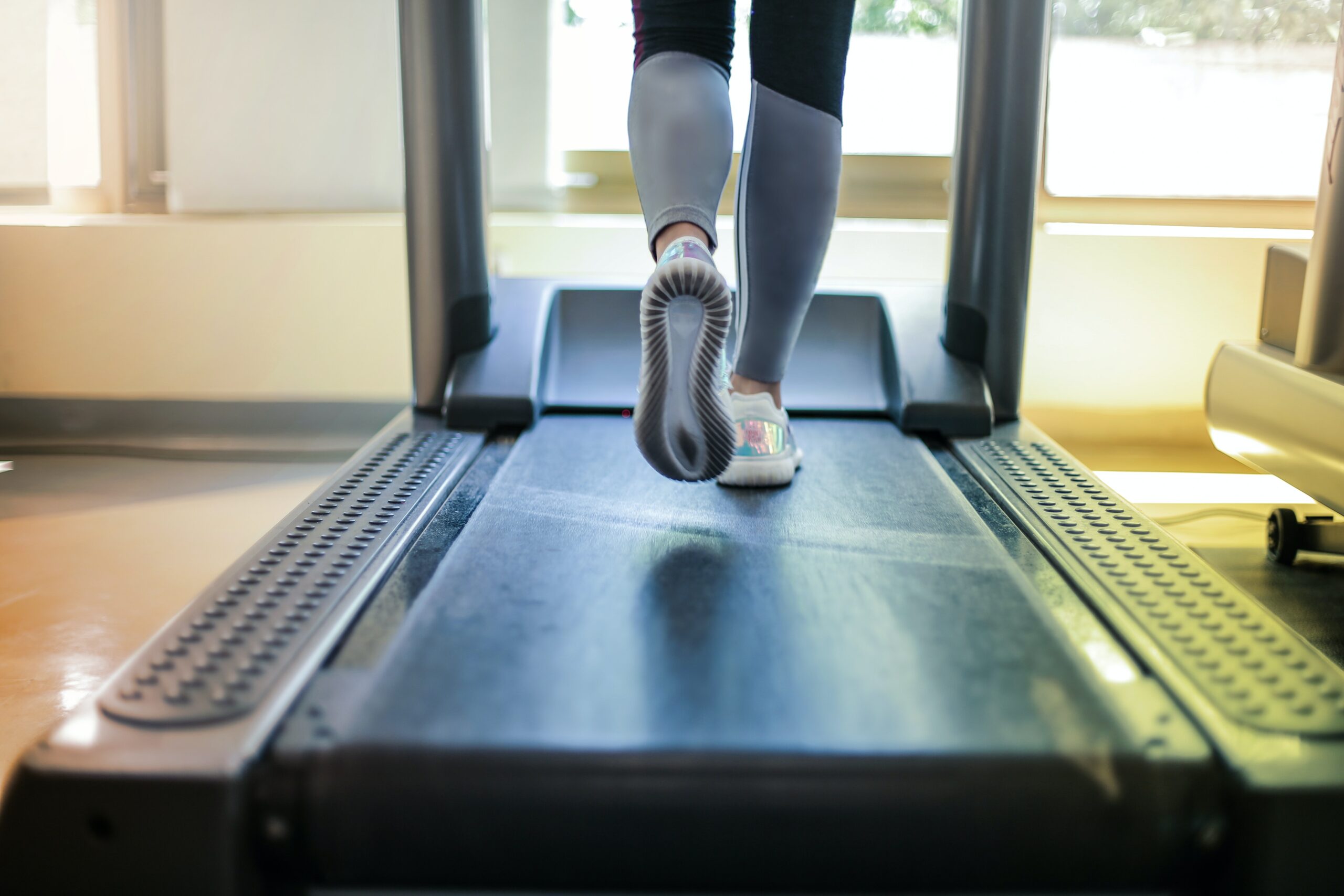
Picking the right cardio machine to add to your at-home gym is essential. If you buy a piece of equipment that you don’t enjoy using, you will probably find that you don’t incorporate it into your at home workouts very often. For example, if walking and running isn’t your thing, a treadmill is most likely not the cardio machine for you. You may want to consider an elliptical or rowing machine instead.
For more intense cardio workouts, treadmills and stair climbers are great options. You can adjust the intensity to suit your own cardio goals and needs. For lower impact workouts, rowing machines and ellipticals or stationary bikes tend to cause less stress on joints and are perfect if you are sore from yesterday’s workout. Rowing machines are also an excellent option for people who want to exercise their whole body during their cardio routine.
Like squat racks, cardio machines can occupy quite a bit of space in your at-home gym. Luckily there are some space saving options out there for tighter squeezes. Foldable treadmills can be easily tucked away when they are not in use, and many ellipticals are more compact for home gyms.
The bottom line is that cardio machines are not one size fits all, and cardio machines can be pricey. We suggest testing out different machines at your local Muskoka gym to find out what works best for you before making a purchase.
Get started on your at-home gym today with Muskoka fitness experts, Shock Fitness!
We have outlined some of the most essential pieces of equipment for an at home gym, but there are many other awesome items that you might consider including. Here are some nice-to-have additions to your gym:
- Gym mats
- Jump ropes
- Pull-up bars
- Full length mirrors
- TRX trainers
Home gyms are not one size fits all! Your budget, space requirements, and fitness goals should all come into play when building your at-home gym. If you are looking for personalised advice, get in touch with our team at Shock Fitness. We offer a comprehensive build-a-gym service to help you get the most out of your home gym. From equipment to custom floors, we are a one-stop shop for creating your ideal gym in your own home.
